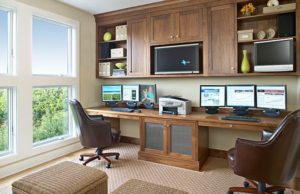If you use part of your home for business, the IRS will generally allow you to deduct certain expenses come tax time. The home office deduction is available for homeowners AND renters, and applies to all types of homes. In order to take the deduction, there are two basic requirements that you must satisfy:
Regular and Exclusive Use
You must “regularly” use part of your home “exclusively” for conducting business. For example, if you use an extra room to run your business, you can take a home office deduction for that extra room. The exclusive portion of the equation usually means that you can’t use that room for other things. Meaning, if the room is your den and you also use it for entertainment or other social activities, then the deduction will not be allowed. Also, if the room or space isn’t used on a regular basis (i.e. you only have business meetings in that room once a quarter), the deduction will also not be allowed.
Principal Place of Your Business
In addition to the above, you must show that you use your home as your principal place of business. If you conduct business at a location outside of your home, but also use your home substantially and regularly to conduct business, you may qualify for a home office deduction. For example, if you have in-person meetings with patients, clients, or customers in your home, even though you also carry on business at another location, you can deduct your expenses for the part of your home used exclusively and regularly for business. You can deduct expenses for a separate free-standing structure, such as a studio, garage, or barn, if you use it exclusively and regularly for your business.
How to claim the deduction
Generally, deductions for a home office are based on the percentage of your home devoted to business use. Thus, if you use whole or part of a room for conducting your business, you will generally need to figure out the percentage of your home devoted to your business activities. However, note that there are TWO methods for you to determine the deduction:
Simplified Method
For taxable years that started on or after, January 1, 2013 (filed beginning in 2014), taxpayers have the option of using the simple method per IRS Revenue Procedure 2013-13. The standard method (discussed next) has some calculation, allocation, and substantiation requirements that some consider complex and burdensome for small business owners. The simplified option can significantly reduce the recordkeeping burden by allowing a qualified taxpayer to multiply a prescribed rate by the allowable square footage of the office. In most cases, the deduction is calculated by multiplying $5, the prescribed rate, by the area of your home used for a qualified business use. However, note that the area you use to figure your deduction is limited to 300 square feet. So if your office is larger than this number, you may want to take the time to use the next method.
Regular Method
Taxpayers who use the regular method (required for tax years 2012 and prior), must determine the actual expenses associated with their home office. These expenses may include mortgage interest, insurance, utilities, repairs, and depreciation. Once the amount spent on each category is determined, one must then allocate them between the space used in connection with their business and the rest of the dwelling. To do this, one will use IRS Form 8829.
Where to deduct
Where you take the deduction on your tax return depends on how you conduct your business:
- If you are self-employed: report the entire deduction on line 30 of Schedule C (Form 1040). Whether you need to complete and attach Form 8829 to your return depends on which method you used above to perform your calculation.
- If you are an employee: you must itemize deductions on Schedule A (Form 1040) to claim the deduction, generally on line 21 (unreimbursed employee business expenses).
- If you are a member of a partnership, multimemeber LLC or S-Corp: take a look at this post for more information on how to claim the deduction.
To learn more about the following, we suggest that you take a look at IRS Publication 587:
- Types of expenses you can deduct.
- How to figure the deduction (including depreciation of your home).
- Special rules for daycare providers.
- Tax implications of selling a home that was used partly for business.
- Records you should keep


